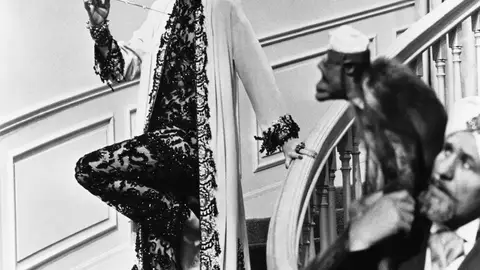Notes on High Camp and High Fashion: 5 Essential Films

"Indeed the essence of Camp is its love of the unnatural: of artifice and exaggeration." —Susan Sontag, "Notes on Camp", 1964
"Florals? For Spring. Groundbreaking." — Miranda Priestley, The Devil Wears Prada ,2006
For lovers of fashion the world over, the first Monday in May is their Super Bowl, their Oscars, their Endgame. The Met Gala is the ultimate. And this year promises to be one of the best on record, with a theme drawing inspiration from Susan Sontag's seminal 1964 essay, "Notes on Camp."
Attendees, thus, have carte blanche to fully explore their love of "artifice and exaggeration" that Sontag defines as the essence of camp. Some will shine, others will, inevitably, disappoint, depending on their understanding and interpretation of camp.
What is camp, really? One aspect of it is queerness. Drag is camp. It is artifice and exaggeration distilled to its purest form. Camp is delighting in the absurd. It's not taking oneself too seriously. It's looking at the world and seeing what could be and not just what is.
That being said, there's a long history of camp from which to draw inspiration, with some of the best examples preserved on film. Here, a brief history of the finest and most fashionable camp movies to burst out of the celluloid closet.
The Women, 1939
George Cukor's 1939 classic was groundbreaking for the time in that its cast was entirely female—even the animals and the majority of the background artwork used in the film were of the fairer sex. Cukor, whose homosexuality was well-known in Hollywood, was famed for being a "women's director" so he was the perfect choice to helm the ultimate women's picture.
Screen queens Joan Crawford, Norma Shearer, and Rosalind Russell lead the brilliant ensemble as they bitch, banter, and brazenly fail the Bechdel Test in gowns by famed Hollywood couturier Adrian, who gets to indulge his most outré impulses.
Aside from the witty one-liners ("There's a name for you ladies, but it isn't used in high society...outside of a kennel."), what really puts The Women over the proverbial top is a five-minute fashion show.
Filmed in the still relatively new Technicolor, the show serves no real purpose other than being an exercise in ostentatious glamour. The only exercise camp requires.
Auntie Mame, 1958
Roz Russell delivered her greatest and most memorable performance as camp icon Mame Dennis, the freewheeling, high-living, fashion-loving protagonist of Patrick Dennis's 1955 novel. Mame is the epitome of camp. She is extravagance, she is opulence, she is and owns everything.
Along with boozy bestie Vera Charles (Coral Browne), Mame absolutely devours life, the banquet at which most poor suckers are starving to death—and they look stunning while doing it.
Mame has also had one of the longest lives of a camp character, first appearing in the 1955 novel, then the 1956 play, followed by the 1958 film, then the 1966 musical adaptation Mame starring Angela Lansbury and Bea Arthur, and the 1974 musical film with fellow camp icons Lucille Ball and Arthur, reprising her Tony-winning role as Vera.
The Roz Russell film, however, remains the gold standard.
Mahogany, 1975
Do you know where you're going to? If you're watching Mahogany, the answer is straight to the top, baby! Diana Ross stars as struggling fashion designer Tracy Chambers, who finds success and fame as supermodel of the world Mahogany—but at what cost?
Featuring one of the most epic fashion montages in movie history—heavily referenced decades later in Dreamgirls with Beyoncé serving her best Ms. Ross realness—Mahogany is camp because it's so unapologetically outrageous.
By the time Diana Ross screams "I'm a winner, baby!", emerges from a fatal car crash looking relatively flawless, and mounts a kimono-clad comeback, you're well-aware that this film has gone off the rails.
And you're much better for it.
Troop Beverly Hills, 1989
According to comedian Brendan Scannell, Phyllis Nefler is the "only camp icon of the past 100 years worth mentioning." The hyperbole in that statement is camp in itself, but Scannell isn't completely wrong. Troop Beverly Hills is a touchstone for many a kid, particularly a gay kid, of the '80s/early '90s.
Shelley Long's never been better as the posh but oblivious Beverly Hills housewife who rediscovers herself with the help of her off-brand Girl Scout troop. Phyllis' costumes are ridiculous and impractical in the most fabulous way possible, reflective of how delightfully out-of-touch she is with the rest of the world.
The entire conceit of the film is that it's funny to force a pampered lady of leisure to "rough it," but the true comedy comes from how she manages to succeed on her own impossibly stylish terms.
In the end, you can't keep a good woman with an unlimited credit line down.
The Devil Wears Prada, 2006
The Devil Wears Prada is an all right film, but Meryl Streep elevates it to true camp genius as steely fashion editrix Miranda Priestley. Each line is delivered with such inveterate bitchiness, each look with such withering disdain, that her performance actually transcends camp—which is often mistakenly derided as lacking quality—to achieve universal acclaim.
While Anne Hathaway anchors the film as the young, aspiring "serious writer" Andy Sachs, Emily Blunt and Stanely Tucci round out the film's camp sensibility, relishing the absurd world of fashion that Andy is desperate to leave.
But Devil belongs to Streep. If anything, fashion is about artifice and exaggeration and Miranda Priestley is the high priestess of fashion and, by extension, those qualities. She is camp personified.
Truly groundbreaking.





